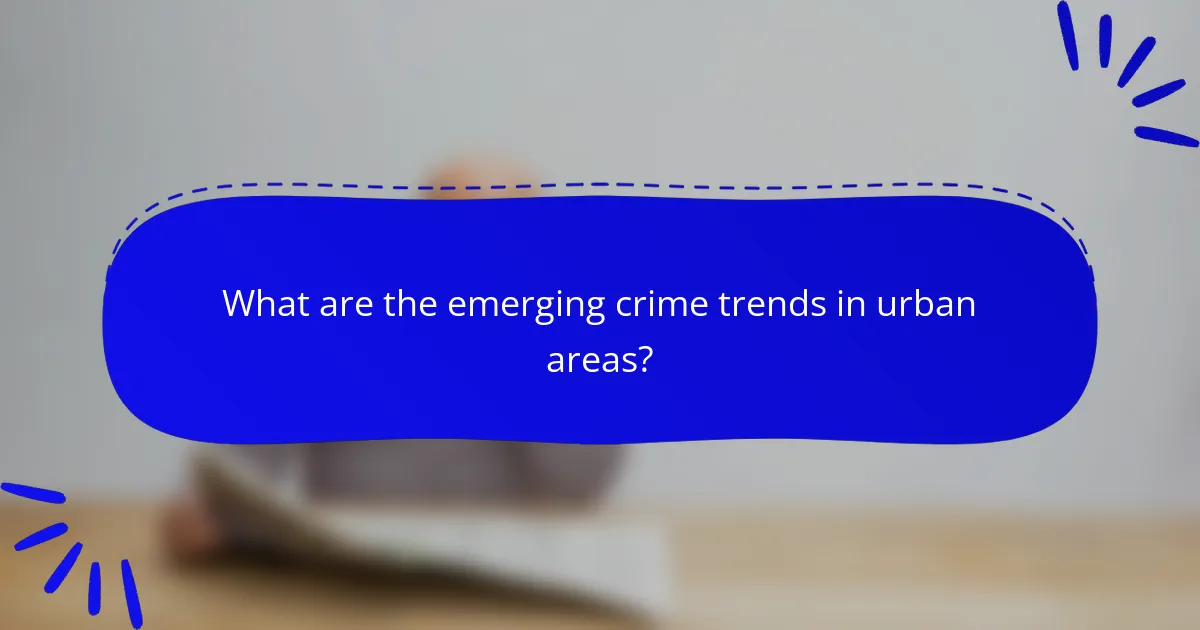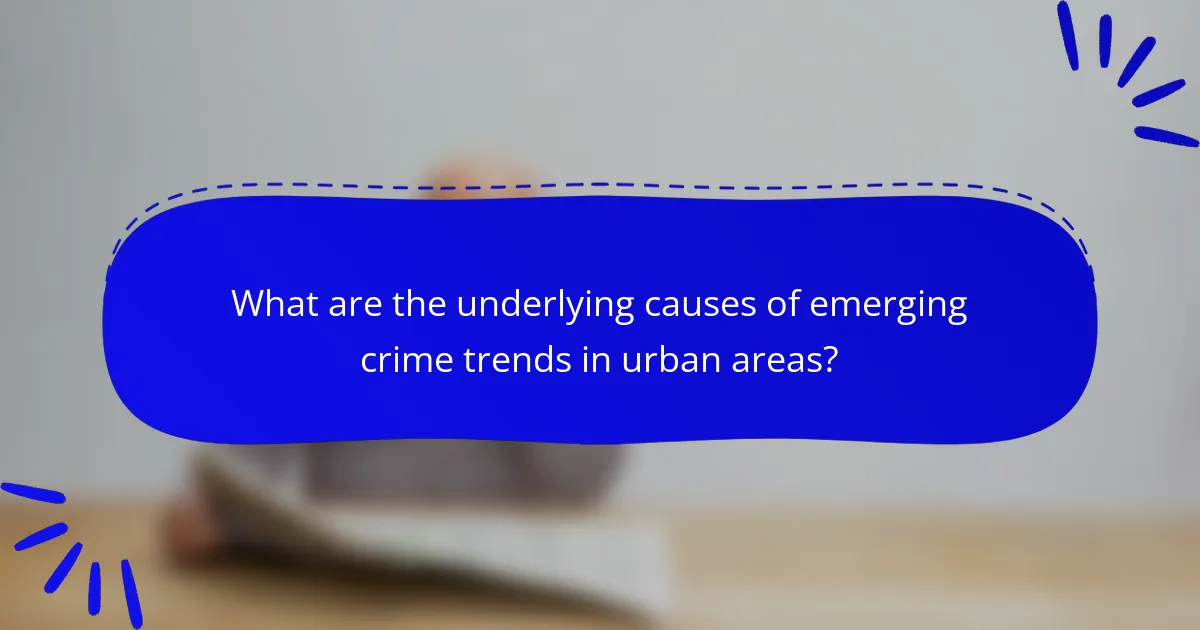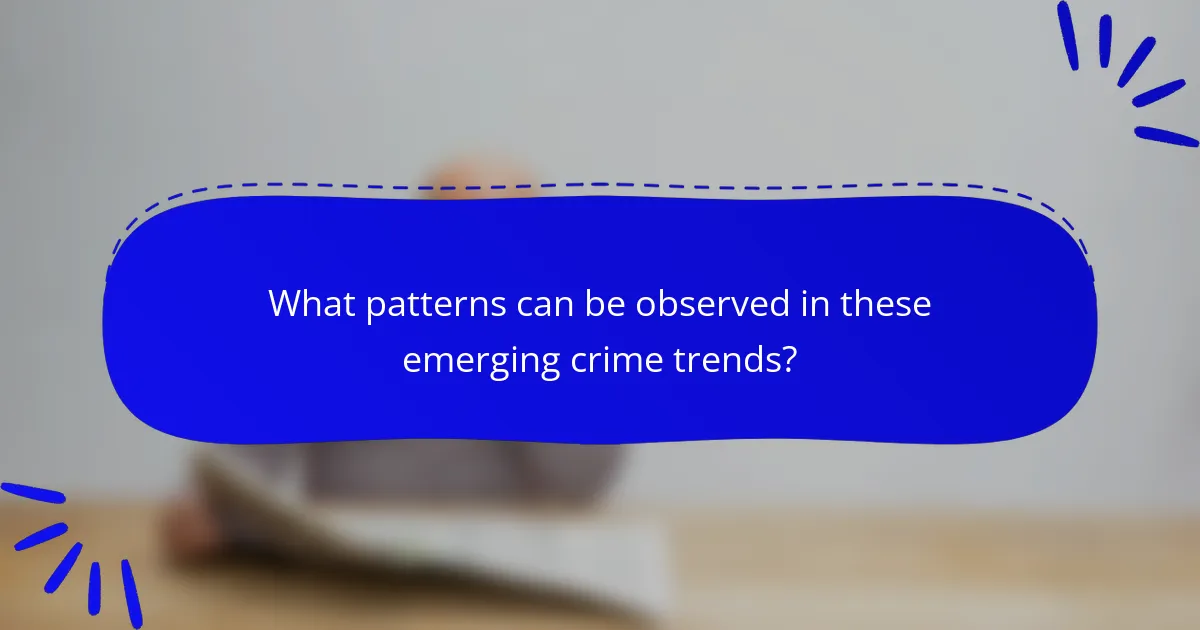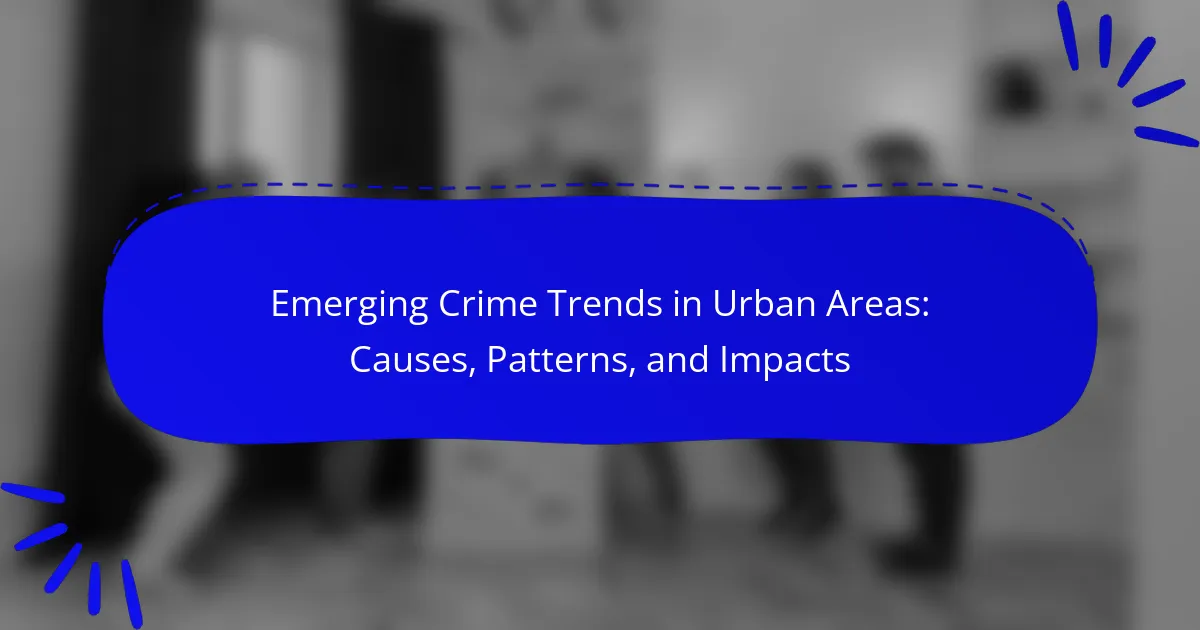
What are the emerging crime trends in urban areas?
Emerging crime trends in urban areas include an increase in cybercrime, drug-related offenses, and violent crimes. Cybercrime has surged due to greater internet access and reliance on digital platforms. According to the FBI’s Internet Crime Complaint Center, reported cybercrimes reached over 300,000 incidents in 2020. Drug-related offenses have risen, particularly with the opioid crisis affecting cities nationwide. The National Institute on Drug Abuse reported a significant increase in overdose deaths in urban areas. Violent crimes, such as shootings and homicides, have also seen a rise in some cities, with the FBI reporting a 30% increase in homicides in 2020 compared to the previous year. These trends reflect changing societal dynamics and the need for updated law enforcement strategies.
How do these trends differ from traditional crime patterns?
Emerging crime trends differ from traditional crime patterns primarily in their methods and motivations. Traditional crime often involved direct confrontations and physical altercations. In contrast, emerging trends frequently utilize technology and cyber means. Cybercrime, for instance, has surged, with 2020 seeing a 400% increase in reported incidents according to the FBI. Additionally, emerging trends often reflect socio-economic factors, such as economic disparities and social unrest, which were less pronounced in traditional crime. The rise in organized crime networks also contrasts with more localized traditional crime. These trends indicate a shift towards more sophisticated, less visible forms of crime compared to the overt nature of traditional offenses.
What factors contribute to the evolution of these crime trends?
Economic instability contributes significantly to the evolution of crime trends. When unemployment rates rise, individuals may resort to crime for financial survival. Urban areas often experience higher poverty levels, leading to increased criminal activities. Social disorganization also plays a critical role. Communities with weak social ties tend to have higher crime rates. Additionally, changes in policing strategies can influence crime trends. For instance, community policing may reduce crime in certain neighborhoods. Technological advancements impact crime as well. Cybercrime has surged due to increased internet usage. Finally, cultural shifts can affect crime patterns. Changes in societal norms may lead to more acceptance of certain criminal behaviors.
How do socio-economic conditions influence emerging crime trends?
Socio-economic conditions significantly influence emerging crime trends. High unemployment rates often correlate with increased property crimes. Areas with poverty may experience higher rates of violent crimes. Economic instability can lead to desperation, prompting criminal behavior. Research by the Bureau of Justice Statistics shows that regions with lower income levels have higher crime rates. Additionally, lack of access to education limits job opportunities, further contributing to crime. Social disorganization theory indicates that communities with weak social structures often face rising crime rates. Thus, socio-economic factors are critical in understanding and addressing crime trends.
What types of crimes are becoming more prevalent in urban settings?
Violent crimes, property crimes, and cybercrimes are becoming more prevalent in urban settings. Violent crimes include assaults, homicides, and robberies. These offenses often rise in densely populated areas due to increased social tensions. Property crimes, such as theft and burglary, also show a significant uptick. Urban environments provide more opportunities for such crimes due to higher population density and economic disparities. Additionally, cybercrimes are increasing as more people rely on technology and the internet for daily activities. The FBI reported a 69% increase in cybercrime complaints from 2019 to 2020. These trends indicate a shift in the types of criminal activities affecting urban communities.
What role does technology play in facilitating new crime types?
Technology plays a significant role in facilitating new crime types. It provides tools and platforms that enable criminal activities. Cybercrime has surged due to the internet’s accessibility. Criminals exploit online anonymity to commit fraud and identity theft. Advanced technologies like encryption can hinder law enforcement efforts. Social media platforms are used for orchestrating illegal activities. The rise of cryptocurrencies has enabled untraceable transactions. Moreover, technology aids in the creation of sophisticated malware. According to the Cybersecurity and Infrastructure Security Agency, cyber incidents have increased by over 300% since 2019.
How do gang activities manifest in urban crime trends?
Gang activities manifest in urban crime trends primarily through increased violence and drug-related offenses. Gangs often compete for territory, leading to violent confrontations. This competition results in higher homicide rates in gang-affected neighborhoods. Moreover, gang involvement in drug trafficking contributes significantly to urban crime statistics. According to the FBI’s Uniform Crime Reporting Program, cities with active gangs report elevated rates of violent crime. Additionally, gang-related crimes often include robbery and extortion, impacting local businesses. The presence of gangs can also lead to a pervasive sense of fear within communities, affecting overall safety. Urban areas with high gang activity often experience a cycle of crime that is difficult to break.

What are the underlying causes of emerging crime trends in urban areas?
Emerging crime trends in urban areas are primarily caused by socioeconomic factors, changes in community structure, and technological advancements. High poverty rates often lead to increased crime as individuals seek desperate means for survival. Urban areas with high unemployment rates experience more property crimes and violent offenses. Additionally, the breakdown of social cohesion can contribute to rising crime rates. Disconnected communities often lack the social networks that can deter criminal behavior. The proliferation of technology also plays a role in emerging crime trends. Cybercrime is on the rise as more individuals have access to the internet. Urban areas are particularly vulnerable due to dense populations and greater anonymity. Furthermore, drug abuse and addiction contribute significantly to crime rates in cities. The opioid crisis, for instance, has led to increased theft and violence. Overall, these factors create an environment conducive to emerging crime trends in urban settings.
How do social dynamics contribute to crime rates in cities?
Social dynamics significantly influence crime rates in cities. Factors such as socioeconomic status, community cohesion, and social disorganization play critical roles. Areas with high poverty levels often experience increased crime rates. Social disorganization theory suggests that weakened social structures lead to higher crime. For instance, neighborhoods lacking strong community ties may have less informal social control. Research indicates that cities with greater income inequality face elevated crime rates. A study by the National Institute of Justice found that social cohesion can reduce crime by fostering mutual trust among residents. Therefore, understanding these dynamics is essential for addressing urban crime effectively.
What impact does poverty have on crime emergence?
Poverty significantly increases the likelihood of crime emergence. Individuals facing economic hardship may resort to illegal activities for survival. Research indicates that areas with high poverty rates experience higher crime rates. According to the FBI’s Uniform Crime Reporting Program, cities with elevated poverty levels report more violent crimes. Additionally, socioeconomic stressors can lead to increased theft and property crimes. A study by the National Institute of Justice found a direct correlation between poverty and crime rates in urban settings. This relationship suggests that addressing poverty may help reduce crime levels.
How does urbanization affect crime patterns?
Urbanization typically leads to increased crime rates in urban areas. This phenomenon occurs due to factors such as population density and socioeconomic disparities. Higher population density can create opportunities for crime, as more individuals interact in confined spaces. Socioeconomic disparities often result in higher levels of poverty and unemployment, which can correlate with increased criminal activity.
A study by the United Nations Office on Drugs and Crime found that urban areas experience higher rates of violent crime compared to rural areas. Furthermore, urbanization can strain public services and law enforcement, making it harder to maintain safety. Increased anonymity in cities may also embolden criminal behavior.
Overall, urbanization influences crime patterns through a combination of environmental, social, and economic factors.
What psychological factors may drive individuals toward crime?
Psychological factors that may drive individuals toward crime include a range of influences. These factors often manifest as personality traits, mental health issues, or environmental influences. For instance, individuals with antisocial personality disorder may exhibit a lack of empathy, leading to criminal behavior. Research indicates that childhood trauma can significantly increase the likelihood of engaging in criminal activities. Studies show that exposure to violence in early life correlates with future criminal behavior. Additionally, socio-economic stressors can exacerbate feelings of desperation, pushing individuals toward crime as a means of survival. Substance abuse is another psychological factor, often impairing judgment and increasing impulsivity. Overall, these psychological influences create a complex interplay that can lead to criminal actions.
How do community disintegration and lack of social cohesion influence criminal behavior?
Community disintegration and lack of social cohesion significantly influence criminal behavior. Disintegrated communities often lack trust among residents. This absence of trust reduces informal social controls. When social controls weaken, criminal activities may increase. Research indicates that neighborhoods with strong social ties report lower crime rates. A study by Sampson and Groves (1989) found that social cohesion directly correlates with lower levels of violence. Additionally, communities with high levels of disorganization often experience higher rates of gang activity. In these environments, individuals may feel isolated and resort to crime for social connection or economic gain. Thus, community disintegration creates conditions that facilitate criminal behavior.
What role does substance abuse play in emerging crime trends?
Substance abuse significantly contributes to emerging crime trends. It often leads to increased criminal behavior, including theft, violence, and drug-related offenses. According to the National Institute on Drug Abuse, individuals under the influence of substances may engage in risky behaviors. Substance abuse can impair judgment and reduce impulse control. This impairment can escalate conflicts and lead to violent encounters. Additionally, drug trafficking and distribution are directly linked to substance abuse. The opioid crisis, for example, has fueled an increase in property crimes and overdose-related deaths. Communities with high rates of substance abuse often experience a rise in gang activity and organized crime. Overall, the relationship between substance abuse and crime is well-documented and critical for understanding urban crime trends.

What patterns can be observed in these emerging crime trends?
Emerging crime trends in urban areas show several observable patterns. One pattern is the increase in cybercrime due to greater internet accessibility. Statistics indicate that cybercrime rates rose by 300% during the COVID-19 pandemic. Another pattern is the rise in violent crimes linked to economic hardship and social unrest. For instance, cities with higher unemployment rates reported a 20% increase in violent incidents. Additionally, drug-related crimes have shifted from traditional trafficking to online sales platforms. Reports show that 60% of drug transactions now occur via the dark web. Finally, there is a trend of increased gang-related activities in urban neighborhoods, often fueled by social media. Research indicates that 70% of gang recruitment occurs through online channels. These patterns highlight the evolving nature of crime in urban settings.
How do demographic factors affect crime trends in urban areas?
Demographic factors significantly influence crime trends in urban areas. Population density correlates with higher crime rates, particularly in economically disadvantaged neighborhoods. Areas with a younger population often experience increased rates of violent crime. Ethnic diversity can lead to both increased social cohesion and tension, impacting crime levels. Research shows that unemployment rates, particularly among young males, are linked to higher crime rates. For example, the Bureau of Justice Statistics reports that areas with high unemployment often see spikes in property crimes. Additionally, educational attainment affects crime trends; lower levels of education are associated with higher crime rates. Overall, demographic characteristics shape the social and economic landscape, directly impacting crime patterns in urban settings.
What are the age and gender profiles of individuals involved in emerging crimes?
Individuals involved in emerging crimes typically range from late teens to early thirties. A significant proportion of these individuals are male. Research indicates that young males aged 18 to 24 are particularly overrepresented. For instance, a study by the Bureau of Justice Statistics found that this demographic accounts for a substantial share of arrests related to emerging crime trends. Additionally, females are increasingly involved, though they represent a smaller percentage. This trend highlights a shift in the demographic landscape of crime involvement.
How does the time of day influence crime occurrences in urban settings?
Crime occurrences in urban settings vary significantly by the time of day. Research indicates that certain types of crime peak during specific hours. For instance, violent crimes often rise during late-night hours, particularly between 10 PM and 2 AM. This trend correlates with increased nightlife activities and alcohol consumption. Property crimes, such as burglaries, tend to occur more frequently during the day when homes are unoccupied. A study by the Bureau of Justice Statistics shows that 60% of burglaries happen during daylight hours. Additionally, the presence of people in public spaces influences crime rates. Areas with higher foot traffic during the day may experience more thefts, while nighttime can lead to more assaults. Overall, the time of day plays a crucial role in shaping crime patterns in urban environments.
What geographical areas are most affected by these crime trends?
Urban areas with high population density are most affected by emerging crime trends. Cities like Chicago, Los Angeles, and New York experience significant crime rates. These areas often face issues such as gang violence, drug-related crimes, and property crimes. According to the FBI’s Uniform Crime Reporting Program, urban centers account for a disproportionate share of reported crimes. Socioeconomic factors contribute to these trends, including poverty and unemployment rates. Additionally, neighborhoods with inadequate policing and community resources see higher crime occurrences. Overall, urban areas are critical hotspots for emerging crime trends.
What urban environments are more susceptible to specific crime types?
Urban environments with high population density and economic disparity are more susceptible to specific crime types. Areas with significant poverty often experience higher rates of violent crimes, such as assault and robbery. Urban neighborhoods with a mix of commercial and residential spaces tend to see property crimes, including burglary and theft. High-crime areas often lack adequate policing and community resources, which exacerbates crime rates. For instance, cities like Chicago and Baltimore have documented increased gang-related violence in economically disadvantaged neighborhoods. Studies indicate that urban areas with limited access to education and employment opportunities correlate with higher crime incidents. Furthermore, cities with nightlife districts report elevated rates of alcohol-related offenses, including public disorder and DUI.
How does the presence of law enforcement impact crime patterns in different neighborhoods?
The presence of law enforcement significantly reduces crime rates in neighborhoods. Increased police visibility deters potential offenders. Studies show that neighborhoods with higher police presence experience lower rates of violent crime. For example, a study by the National Institute of Justice found that areas with community policing initiatives saw a 20% decrease in crime. Additionally, consistent patrols and quick response times enhance public safety. Law enforcement also fosters community trust, leading to greater cooperation in reporting crimes. Ultimately, effective law enforcement strategies create safer environments and alter crime patterns positively.
What are the broader impacts of emerging crime trends on urban communities?
Emerging crime trends significantly impact urban communities. They contribute to increased fear and anxiety among residents. This fear can lead to social isolation and decreased community engagement. Additionally, rising crime rates can deter businesses and investors from entering these areas. Economic decline often follows, resulting in job losses and reduced public services. Increased crime also places a burden on local law enforcement and emergency services. These strains can lead to resource allocation issues, affecting community safety. Furthermore, the stigma associated with high crime areas can perpetuate cycles of poverty and disadvantage.
How do crime trends affect public perception of safety?
Crime trends significantly influence public perception of safety. When crime rates rise, individuals often feel less secure in their communities. This heightened fear can lead to increased anxiety and a sense of vulnerability. For instance, a study by the Bureau of Justice Statistics found that areas with rising crime rates saw a 20% increase in residents reporting feelings of unsafety. Conversely, declining crime rates can enhance public confidence and a sense of community well-being. Surveys consistently show that people are more likely to feel secure in neighborhoods with low crime statistics. Thus, crime trends directly correlate with how safe people feel in their environments.
What economic consequences do urban crime trends have on local businesses?
Urban crime trends negatively impact local businesses through increased operational costs and reduced customer traffic. Businesses often face higher insurance premiums due to crime-related risks. Additionally, theft and vandalism lead to direct financial losses. Increased security measures, such as hiring security personnel or installing surveillance systems, further raise expenses. Local businesses may also experience decreased sales as customers avoid areas perceived as unsafe. According to a study by the Institute for Economics and Peace, urban areas with high crime rates see a significant decline in business investment. This trend can stifle economic growth and reduce job opportunities in the community.
What strategies can urban communities adopt to combat emerging crime trends?
Urban communities can adopt several strategies to combat emerging crime trends. Implementing community policing builds trust between law enforcement and residents. Increased surveillance through cameras deters criminal activity in high-risk areas. Engaging local organizations fosters neighborhood watch programs, enhancing community vigilance. Offering youth programs can reduce crime by providing positive alternatives. Enhancing street lighting improves visibility, making areas safer at night. Data-driven policing uses crime statistics to allocate resources effectively. Collaborating with social services addresses underlying issues contributing to crime. These strategies have proven effective in various urban settings, leading to reduced crime rates and improved community safety.
How can community engagement reduce crime rates in urban areas?
Community engagement can reduce crime rates in urban areas by fostering trust and collaboration between residents and law enforcement. When community members actively participate in neighborhood watch programs, crime prevention initiatives, and local meetings, they become more vigilant and aware of their surroundings. This increased awareness often leads to quicker reporting of suspicious activities.
Additionally, engaged communities can identify and address underlying social issues, such as poverty and lack of resources, that contribute to crime. According to a study by the National Institute of Justice, neighborhoods with strong social cohesion experience lower crime rates. Moreover, community programs that provide youth with positive activities and mentorship can deter them from engaging in criminal behavior.
Research shows that cities implementing community policing strategies have seen significant declines in crime. For example, a report by the Urban Institute found that community-driven policing efforts led to a 30% reduction in violent crime in targeted neighborhoods. Thus, community engagement is a vital element in creating safer urban environments.
What role does education play in preventing crime in cities?
Education plays a crucial role in preventing crime in cities. It equips individuals with knowledge and skills that enhance employability. Higher education levels correlate with lower crime rates, as educated individuals are less likely to engage in criminal activities. According to a study by the Institute for Economics and Peace, increasing education can reduce crime by up to 50%. Education also promotes social cohesion and community engagement, which are essential in crime prevention. Programs that focus on youth education can deter at-risk individuals from pursuing criminal paths. Furthermore, education fosters critical thinking and decision-making skills, which help individuals make better life choices. Overall, education serves as a foundational element in reducing crime in urban environments.
Emerging crime trends in urban areas encompass a rise in cybercrime, drug-related offenses, and violent crimes, driven by socio-economic factors and technological advancements. Key patterns include increased criminal activities linked to economic instability, community disintegration, and the influence of gangs. The article examines the underlying causes of these trends, such as poverty and social dynamics, and their broader impacts on community safety and local economies. It also discusses strategies for combating crime through community engagement and education, highlighting the importance of addressing root causes to reduce crime rates effectively.
